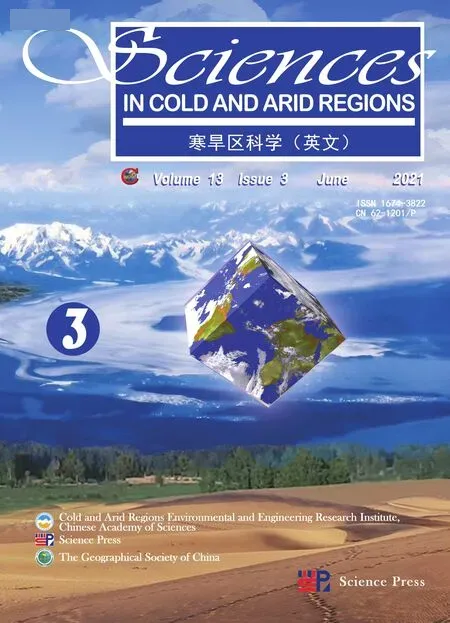Linkages between soil microbial stability and carbon storage in the active layer under permafrost degradation
ShengYun Chen ,MingHui Wu ,Yu Zhang ,Kai Xue
1.Cryosphere and Eco-Environment Research Station of Shule River Headwaters,State Key Laboratory of Cryospheric Science,Northwest Institute of Eco-Environment and Resources,Chinese Academy of Sciences,Lanzhou,Gansu 730000,China
2.Long-term National Scientific Research Base of the Qilian Mountain National Park,Xining,Qinghai 810000,China
3.University of Chinese Academy of Sciences,Beijing 100049,China
The Qinghai-Tibet Plateau (QTP) distributes the largest extent of high-altitude mountain permafrost in the world (Zouet al.,2017),which has different char‐acteristics from high-latitude permafrost (Yanget al.,2010) and stores massive soil carbon.Though being generally ignored,soil carbon pool in the active layer is more active and directly affected by climate change(Chenet al.,2017).Trigged by climate warming,per‐mafrost degradation may decrease soil carbon stabili‐ty (Shur and Jorgenson,2007;Liuet al.,2019),in‐duce massive carbon loss (Haleet al.,2019;Wanget al.,2020),and lead to a positive carbon-climate feed‐back (DeContoet al.,2012;Schuuret al.,2015).However,microbial-mediated mechanisms for soil carbon loss of the active layer in degraded permafrost still remain unclear up to now.
Here,a combination of in-depth analysis of soil microbial communities and their co-occurrence net‐works in the active layer was used to examine how microbial diversity,composition and network struc‐ture respond to permafrost degradation in the alpine ecosystems of the QTP,and whether permafrost degra‐dation promotes destabilizing properties in microbial networks,with potential consequences for ecosystem carbon cycling (Wuet al.,2021).Specifically,an ex‐tensive gradient of permafrost degradation,ranging from stable to extremely unstable permafrost with changes in vegetation and environmental variables(Chenet al.,2012),was carried out by a space-fortime simulation (the spatial pattern that is represented by different types of permafrost shifting to the tempo‐ral series that stands for different stages of permafrost degradation).The study area is located in the Shule River Headwaters of Qilian Mountain National Park Qinghai Area,northeast margin of the QTP.
Permafrost degradation was observed to change the diversity and decline the stability of soil microbial communities in the active layer.Firstly,permafrost degradation decreased bacterial and archaeal richness,increased bacterial and fungal dissimilarities and shift‐ed microbial compositions.Both bacterial and ar‐chaeal richness were significantly lower in severely degraded permafrost than lightly degraded perma‐frost.However,there was no significant change in fungal richness.Bacterial and fungal dissimilarities in‐creased significantly with permafrost degradation.
Secondly,permafrost degradation increased the sensitivity of bacterial,fungal and archaeal communi‐ties to environmental disturbance,as evidenced by higher turnover rates in the distance-decay relation‐ship between soil bacterial,fungal or archaeal commu‐nity similarity and environmental distance in severely degraded permafrost,which was based on climate,vegetation,soil and permafrost variables.
Thirdly,permafrost degradation promoted destabi‐lizing properties in bacterial and fungal networks,in‐cluding increased node connectedness,centrality and complexity of bacterial and fungal network nodes.In‐creases in these properties for nodes indicate lower network stability.This was confirmed by changes in the properties characterizing the whole bacterial or fungal network structure,which displayed a decrease in diameter and modularity,and an increase in transi‐tivity with permafrost degradation.In contrast,node connectedness and centrality,and network diameter,transitivity and modularity,did not alter or changed little with permafrost degradation for archaeal net‐works,although node complexity increased.
Importantly,greater shifts in soil microbial com‐munity compositions of the active layer were associat‐ed with the severe permafrost degradation,as indicat‐ed by increased community dissimilarity,amplified soil carbon change,likely due to stimulated microbial activity and accelerated carbon decomposition(Xueet al.,2016;Liuet al.,2019).In contrast,smaller shifts in soil microbial communities in lightly degraded per‐mafrost were not related to the change in soil carbon storage.As such,these findings point to a potential mechanism for soil carbon loss of the active layer on the QTP,which has been projected by Earth system models(Wanget al.,2020)and has important implica‐tion for carbon-climate feedback.
Taken together,these findings reveal that severe permafrost degradation in the alpine ecosystems de‐creases bacterial and archaeal richness,increases bac‐terial and fungal dissimilarities,and reduces the stabil‐ity of active layer microbial communities,which might trigger cascading effects on ecosystem proper‐ties,especially ecosystem carbon storage and carbon feedback(Figure 1).

Figure 1 The logical framework showing the main results
However,there are still deficiencies that:i) it is hard to objectively determine the ages of different degradation stages of permafrost and reconstruct the historical soil environment over longer time-scales us‐ing space-for-time substitution;and ii) due to the small area involved in this research,its universality on a global scale needs to be further verified.There‐fore,a long-term and large-scale research are neces‐sary to strengthen the recognization of microbial regu‐lation of carbon storage.
Acknowledgments:
This research was financially supported by the Nation‐al Natural Science Foundation of China (41871064),the Second Tibetan Plateau Scientific Expedition and Research Program(2019QZKK0304).
 Sciences in Cold and Arid Regions2021年3期
Sciences in Cold and Arid Regions2021年3期
- Sciences in Cold and Arid Regions的其它文章
- A concise overview on historical black carbon in ice cores and remote lake sediments in the northern hemisphere
- Summary of research on frost heave for subgrade in seasonal frozen ground
- Overview of an early warning system for Glacial Lake outburst flood risk mitigation in Dudh-Koshi Basin,Nepal
- Temporal changes in seasonal precipitation over the Sahara Desert from 1979 to 2016
- Centrifuge model test on performance of thermosyphon cooled sandbags stabilizing warm oil pipeline buried in permafrost
- Changes in morphology and soil nutrient patterns of nebkhas in arid regions along a precipitation gradient
